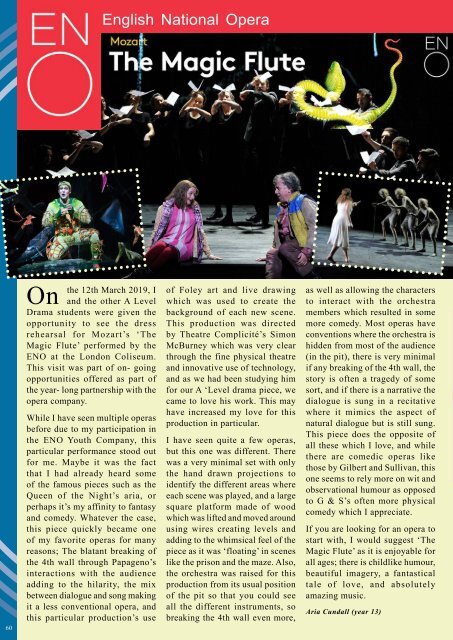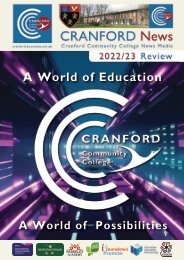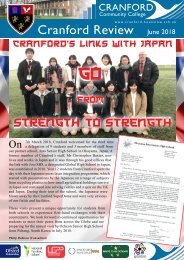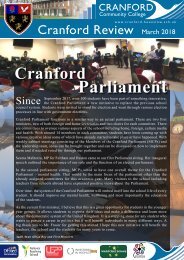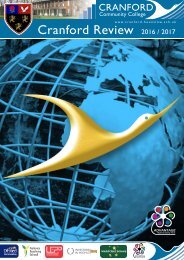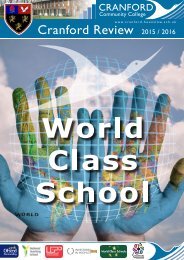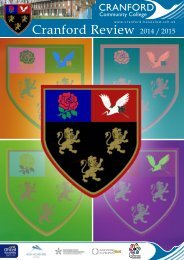Cranford Review 2019
The “Cranford Review” © is a publication of Cranford Community College. Is an annual high standard produced magazine which provides an archive document highlighting various aspects of the life of the academy, its staff, students and community from each academic year. It is a wonderful read and a useful historical document which, with its termly sister publications and occasional special editions, also serves to describe the values of the academy and support the aspirations of the academy, its staff, students and wider community. A colorful layout with a wide range of topics comprising events, extracurricular activities, recognition awards, initiatives, trips and excursions among many others. Hard copies are provided to stakeholders including families, staff, partners, visitors, prospective parents/students, prospective employees and others with an interest or stake in the academy and its students. Headteacher & Director: Kevin Prunty / Editor-in-chief: Jessica Joyce / Graphic Design: Enzo Gianvittorio Danese (Enzo GD) / Printed by: Springfieldpapers.com
The “Cranford Review” © is a publication of Cranford Community College. Is an annual high standard produced magazine which provides an archive document highlighting various aspects of the life of the academy, its staff, students and community from each academic year.
It is a wonderful read and a useful historical document which, with its termly sister publications and occasional special editions, also serves to describe the values of the academy and support the aspirations of the academy, its staff, students and wider community. A colorful layout with a wide range of topics comprising events, extracurricular activities, recognition awards, initiatives, trips and excursions among many others. Hard copies are provided to stakeholders including families, staff, partners, visitors, prospective parents/students, prospective employees and others with an interest or stake in the academy and its students.
Headteacher & Director: Kevin Prunty / Editor-in-chief: Jessica Joyce / Graphic Design: Enzo Gianvittorio Danese (Enzo GD) / Printed by: Springfieldpapers.com
You also want an ePaper? Increase the reach of your titles
YUMPU automatically turns print PDFs into web optimized ePapers that Google loves.
English National Opera<br />
60<br />
On<br />
the 12th March <strong>2019</strong>, I<br />
and the other A Level<br />
Drama students were given the<br />
opportunity to see the dress<br />
rehearsal for Mozart’s ‘The<br />
Magic Flute’ performed by the<br />
ENO at the London Coliseum.<br />
This visit was part of on- going<br />
opportunities offered as part of<br />
the year- long partnership with the<br />
opera company.<br />
While I have seen multiple operas<br />
before due to my participation in<br />
the ENO Youth Company, this<br />
particular performance stood out<br />
for me. Maybe it was the fact<br />
that I had already heard some<br />
of the famous pieces such as the<br />
Queen of the Night’s aria, or<br />
perhaps it’s my affinity to fantasy<br />
and comedy. Whatever the case,<br />
this piece quickly became one<br />
of my favorite operas for many<br />
reasons; The blatant breaking of<br />
the 4th wall through Papageno’s<br />
interactions with the audience<br />
adding to the hilarity, the mix<br />
between dialogue and song making<br />
it a less conventional opera, and<br />
this particular production’s use<br />
of Foley art and live drawing<br />
which was used to create the<br />
background of each new scene.<br />
This production was directed<br />
by Theatre Complicité’s Simon<br />
McBurney which was very clear<br />
through the fine physical theatre<br />
and innovative use of technology,<br />
and as we had been studying him<br />
for our A ‘Level drama piece, we<br />
came to love his work. This may<br />
have increased my love for this<br />
production in particular.<br />
I have seen quite a few operas,<br />
but this one was different. There<br />
was a very minimal set with only<br />
the hand drawn projections to<br />
identify the different areas where<br />
each scene was played, and a large<br />
square platform made of wood<br />
which was lifted and moved around<br />
using wires creating levels and<br />
adding to the whimsical feel of the<br />
piece as it was ‘floating’ in scenes<br />
like the prison and the maze. Also,<br />
the orchestra was raised for this<br />
production from its usual position<br />
of the pit so that you could see<br />
all the different instruments, so<br />
breaking the 4th wall even more,<br />
as well as allowing the characters<br />
to interact with the orchestra<br />
members which resulted in some<br />
more comedy. Most operas have<br />
conventions where the orchestra is<br />
hidden from most of the audience<br />
(in the pit), there is very minimal<br />
if any breaking of the 4th wall, the<br />
story is often a tragedy of some<br />
sort, and if there is a narrative the<br />
dialogue is sung in a recitative<br />
where it mimics the aspect of<br />
natural dialogue but is still sung.<br />
This piece does the opposite of<br />
all these which I love, and while<br />
there are comedic operas like<br />
those by Gilbert and Sullivan, this<br />
one seems to rely more on wit and<br />
observational humour as opposed<br />
to G & S’s often more physical<br />
comedy which I appreciate.<br />
If you are looking for an opera to<br />
start with, I would suggest ‘The<br />
Magic Flute’ as it is enjoyable for<br />
all ages; there is childlike humour,<br />
beautiful imagery, a fantastical<br />
tale of love, and absolutely<br />
amazing music.<br />
Aria Cundall (year 13)


